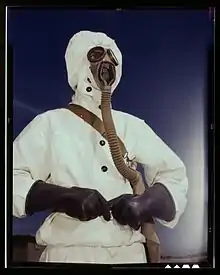Chemical protective clothing
Chemical protective clothing (CPC) is clothing worn to shield those who work with chemicals from the effects of chemical hazards that can cause injuries on the job. It provides a last line of defense for chemical safety; it does not replace more proactive measures like engineering controls.[1]

There are some considerations with chemical protective clothing. For instance, no clothing is "impervious," since all clothing will eventually seep in chemicals. CPC also prevents evaporation, causing skin temperature to increase and potentially increasing the permeability of skin. CPC that has not been tested for the specific operating condition it is used in may not provide adequate protection. The same material, even at the same thickness, may provide different levels of protection depending on the manufacturer, since different manufacturers use different processes and may add different additives. Finally, while the test data will provide information on individual chemicals based on "worst-case scenario" continuous contact testing, most industrial exposures are not continuous and are in fact mixtures of chemical, for which permeation rates are different.[1]
When selecting CPC, it is recommended to determine:[1]
- The chemicals being used
- The state of those chemicals; for example, if they are vaporous, they could be more hazardous
- Whether contact is a result of occasional splashing or a result of more continuous contact
- Whether the worker can be exposed from handling contaminated CPC
- The room temperature where the chemical is being handled
- The parts of the body that the chemical could potentially contact
- Whether the CPC resists physical wear and tear commensurate with the type of work being done
- Whether the CPC interferes with the work, for instance by limiting dexterity
From there, it is recommended that candidate garments should be selected and subject to appropriate testing. Testing is also considered necessary to make sure the material is suitable to the specific condition it will be used in, as opposed to the generic, worst-case scenarios it ordinarily undergoes. Once a garment is selected, it should undergo a limited evaluation with worker training. Once the garment is regularly used it should be regularly evaluated.[1]
References
- "CDC - NIOSH Publications and Products - A Guide for Evaluating the Performance of Chemical Protective Clothing (90-109)". www.cdc.gov. Retrieved 2016-07-15.